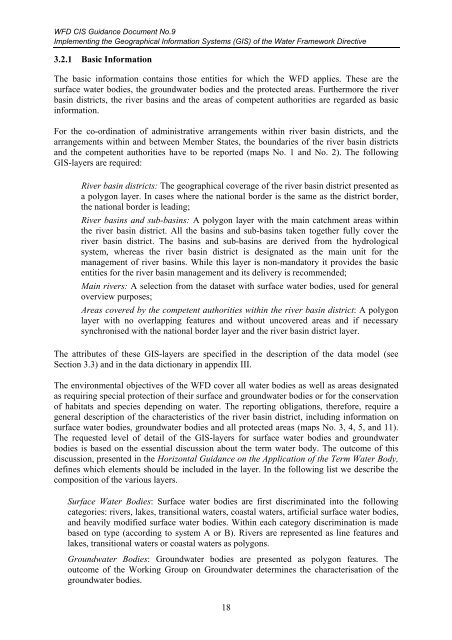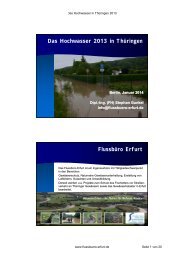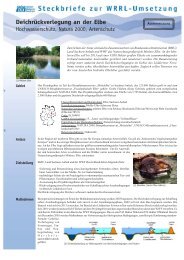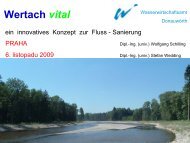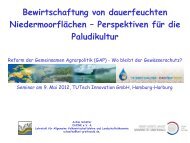Common Implementation Strategy for the Water Framework Directive
Common Implementation Strategy for the Water Framework Directive
Common Implementation Strategy for the Water Framework Directive
Create successful ePaper yourself
Turn your PDF publications into a flip-book with our unique Google optimized e-Paper software.
WFD CIS Guidance Document No.9<br />
Implementing <strong>the</strong> Geographical In<strong>for</strong>mation Systems (GIS) of <strong>the</strong> <strong>Water</strong> <strong>Framework</strong> <strong>Directive</strong><br />
3.2.1 Basic In<strong>for</strong>mation<br />
The basic in<strong>for</strong>mation contains those entities <strong>for</strong> which <strong>the</strong> WFD applies. These are <strong>the</strong><br />
surface water bodies, <strong>the</strong> groundwater bodies and <strong>the</strong> protected areas. Fur<strong>the</strong>rmore <strong>the</strong> river<br />
basin districts, <strong>the</strong> river basins and <strong>the</strong> areas of competent authorities are regarded as basic<br />
in<strong>for</strong>mation.<br />
For <strong>the</strong> co-ordination of administrative arrangements within river basin districts, and <strong>the</strong><br />
arrangements within and between Member States, <strong>the</strong> boundaries of <strong>the</strong> river basin districts<br />
and <strong>the</strong> competent authorities have to be reported (maps No. 1 and No. 2). The following<br />
GIS-layers are required:<br />
�� River basin districts: The geographical coverage of <strong>the</strong> river basin district presented as<br />
a polygon layer. In cases where <strong>the</strong> national border is <strong>the</strong> same as <strong>the</strong> district border,<br />
<strong>the</strong> national border is leading;<br />
�� River basins and sub-basins: A polygon layer with <strong>the</strong> main catchment areas within<br />
<strong>the</strong> river basin district. All <strong>the</strong> basins and sub-basins taken toge<strong>the</strong>r fully cover <strong>the</strong><br />
river basin district. The basins and sub-basins are derived from <strong>the</strong> hydrological<br />
system, whereas <strong>the</strong> river basin district is designated as <strong>the</strong> main unit <strong>for</strong> <strong>the</strong><br />
management of river basins. While this layer is non-mandatory it provides <strong>the</strong> basic<br />
entities <strong>for</strong> <strong>the</strong> river basin management and its delivery is recommended;<br />
�� Main rivers: A selection from <strong>the</strong> dataset with surface water bodies, used <strong>for</strong> general<br />
overview purposes;<br />
�� Areas covered by <strong>the</strong> competent authorities within <strong>the</strong> river basin district: A polygon<br />
layer with no overlapping features and without uncovered areas and if necessary<br />
synchronised with <strong>the</strong> national border layer and <strong>the</strong> river basin district layer.<br />
The attributes of <strong>the</strong>se GIS-layers are specified in <strong>the</strong> description of <strong>the</strong> data model (see<br />
Section 3.3) and in <strong>the</strong> data dictionary in appendix III.<br />
The environmental objectives of <strong>the</strong> WFD cover all water bodies as well as areas designated<br />
as requiring special protection of <strong>the</strong>ir surface and groundwater bodies or <strong>for</strong> <strong>the</strong> conservation<br />
of habitats and species depending on water. The reporting obligations, <strong>the</strong>re<strong>for</strong>e, require a<br />
general description of <strong>the</strong> characteristics of <strong>the</strong> river basin district, including in<strong>for</strong>mation on<br />
surface water bodies, groundwater bodies and all protected areas (maps No. 3, 4, 5, and 11).<br />
The requested level of detail of <strong>the</strong> GIS-layers <strong>for</strong> surface water bodies and groundwater<br />
bodies is based on <strong>the</strong> essential discussion about <strong>the</strong> term water body. The outcome of this<br />
discussion, presented in <strong>the</strong> Horizontal Guidance on <strong>the</strong> Application of <strong>the</strong> Term <strong>Water</strong> Body,<br />
defines which elements should be included in <strong>the</strong> layer. In <strong>the</strong> following list we describe <strong>the</strong><br />
composition of <strong>the</strong> various layers.<br />
�� Surface <strong>Water</strong> Bodies: Surface water bodies are first discriminated into <strong>the</strong> following<br />
categories: rivers, lakes, transitional waters, coastal waters, artificial surface water bodies,<br />
and heavily modified surface water bodies. Within each category discrimination is made<br />
based on type (according to system A or B). Rivers are represented as line features and<br />
lakes, transitional waters or coastal waters as polygons.<br />
�� Groundwater Bodies: Groundwater bodies are presented as polygon features. The<br />
outcome of <strong>the</strong> Working Group on Groundwater determines <strong>the</strong> characterisation of <strong>the</strong><br />
groundwater bodies.<br />
18


